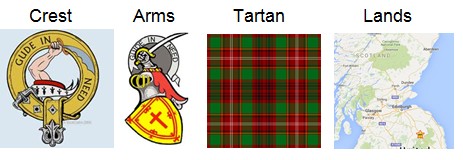Clan Ainslie/Ainsley

Adapted from: http://www.scotclans.com/scottish-clans/clan-ainslie/ OR http://www.electricscotland.com/webclans/index.html
History of the Clan
The name Ainslie most likely derives from Annesley in
Nottinghamshire, England. William de Haneslej who witnessed a charter by
Walter, Bishop of Glasgow (1208-18) is probably the same William de Anslee who
was Canon of Glasgow in 1220. Magister Thomas de Aneslei was one of a number
appointed to settle a dispute between the monks of Kelso and the Hishop of
Glasgow in 1221.
There was also a Ansley in Warwickshire which is recorded as
“Hanslei” in the Domesday Book of 1086, and derives from the Olde English
“ansetl”, hermitage, with “leah”, thin wood, glade, clearing. Annesley in Nottinghamshire
is recorded in the Domesday Book as “Aneslei”, and means “the solitary glade”,
from the Olde English “an”, one, with “leah” as before. Therefore it is most
likely to have originated in Nottinghamshire.
The surname Ainslie is chiefly found in the border areas of
Scotland but before the Normal Conquest it was prominant in England. The modern
forms of the surname are Ainslie, Ainsley, Aynsley and Ainslee. The first
documented people with the surname Ainlie (or a variant of this) were Thomas de
Aneslei (1221, Glasgow); Johan de Anesleye (1296, Roxburghshire); and John de
Annesley (1292, York).
The Saxon lords of Annesley in Nottinghamshire held large
estates, but they fled in the face of the advancing forces of William the
Conqueror to Scotland, where they were received generously by Malcolm III.
The expanding family soon became settled in lands around
Dolphinstone. William de Ainslie, a canon of Glasgow Cathedral, witnessed a
charter by Walter, Bishop of Glasgow, around 1208. In 1221 Thomas de Ainslie
was one of the mediators appointed to settle a dispute between the monks of
Kelso and the bishopric of Glasgow. Sir Aymer de Aynesley was a Borders knight
sent to treat with the English to settle the marches in 1249. There are two
references to the family in the Ragman Roll listing those who submitted to
Edward I of England in 1296: John de Anesleye of Roxburghshire and Johan de
Anesley of Cruwfurt in Laarkshire. Robert de Ainslie, Baron of Dolphinstone,
accompanied his kinsman Patrick, Earl of Dungar and March, on a crusade to the
Holy Land between 1248 and 1254. It seems likely that the Laird of
Dolphinstone, who swore fealty to Edward I, was the crusader’s son, John.
The Ainslies were opposed to Robert the Bruce in his
campaign to win the Scottish Crown and paid for this by loosing their estates. But their fortune changed when
William de Ainslie, who had married Helen Kerr (of the family from which the
present Duke of Roxburgh descends), became a favorite of Robert II. William de Ainslie was given back the estates of Dolphinstone in 1377. The
Anisllies secured their fortunes by strategic alliances by marriage with other
prominent Borders families. They intermarried with the Douglases, Pringles,
Homes and Kerrs. Marjory, daughter of John Ainslie, married Mark Kerr of
Cessford, a doughty warrior known as the Terror of the Borders. He was killed
at the Battle of Pinkie in 1547.
Robert Ainslie, a lawyer who was a Scottish writer and a correspondent of
Robert Burns, the poet., was born on 13 January 1766. He made the poet’s
acquaintance in Edinburgh in the spring of 1787, and they traveled through the
Borders together with Ainslie being received at Burns’ family home.He later
visited Burns at Ellisland where he was given a manuscript copy of Tam o’
Shanter, which he later presented to the writer Sir Walter Scott.
One of his brothers, Sir Whitelaw Ainslie, was medical
superintendent of the Southern Division of India and the author of a detailed
work on Indian native medicine. He was a regular contributor to the Edinburgh
Magazine, and wrote a number of plays. Sir Robert Ainslie was the British
ambassador to the Ottoman Empire at Constantinople from 1776 to 1792. He also
served as a Member of Parliament and was created a baronet in 1804. He is now
best remembered for three volumes of drawings and sketches of Egypt.
The family were also distinguished lawyers, and David
Ainslie of Costerton, who died in 1900, left a fortune amassed from his legal
practice to build the Astley Ainslie Hospital in Edinburgh.
----------
Crest: Issuing
out of a cap of maintenance a naked arm embowed grasping a scymitar all Proper
Arms: The
Ainslie arms clearly allude to their early crusading exploits but even in more
recent times they have enjoyed high military rank. General Charles de Ainslie
commanded the 93rd Highland Regiment, which has now passed into legend as the
‘Thin Red Line’, at the Battle of Balaclave in 1854.
Motto: Pro
Patria Saepe Pro Rege Semper (For country often, for King always)
Historic Seat: Dolphinstone Castle (ruined), Jedburgh
Clan Chief:
None, armigerous clan

